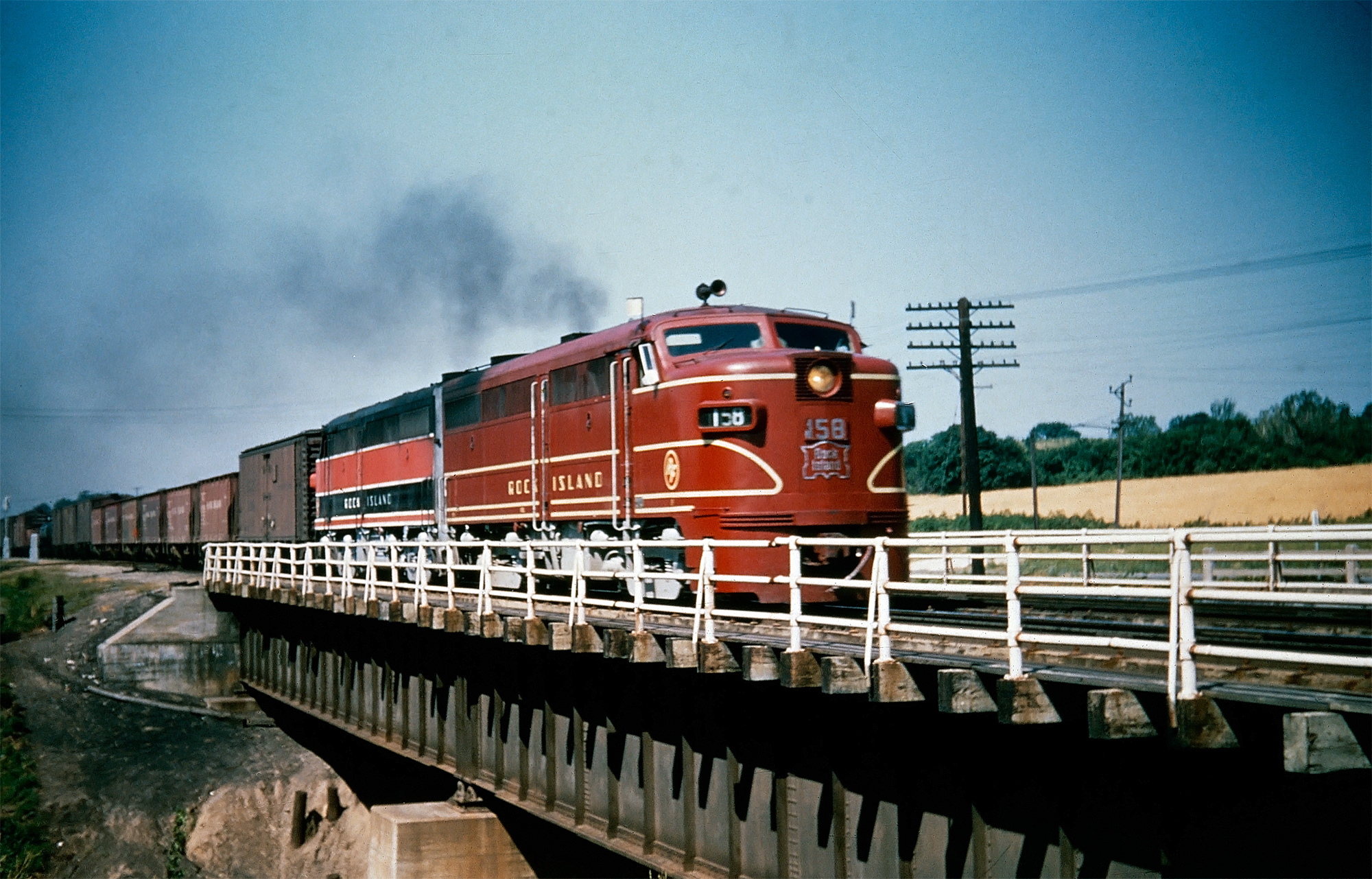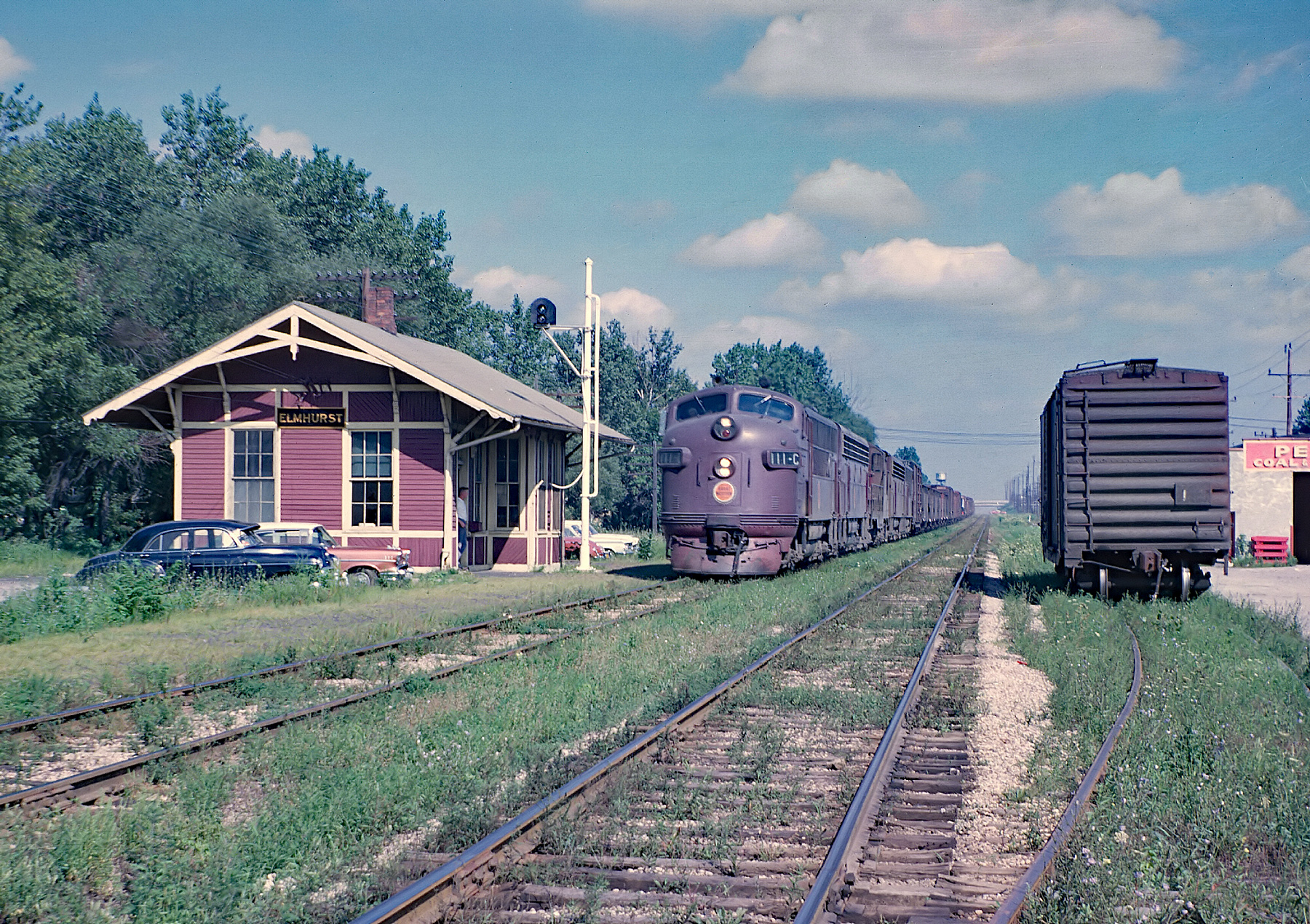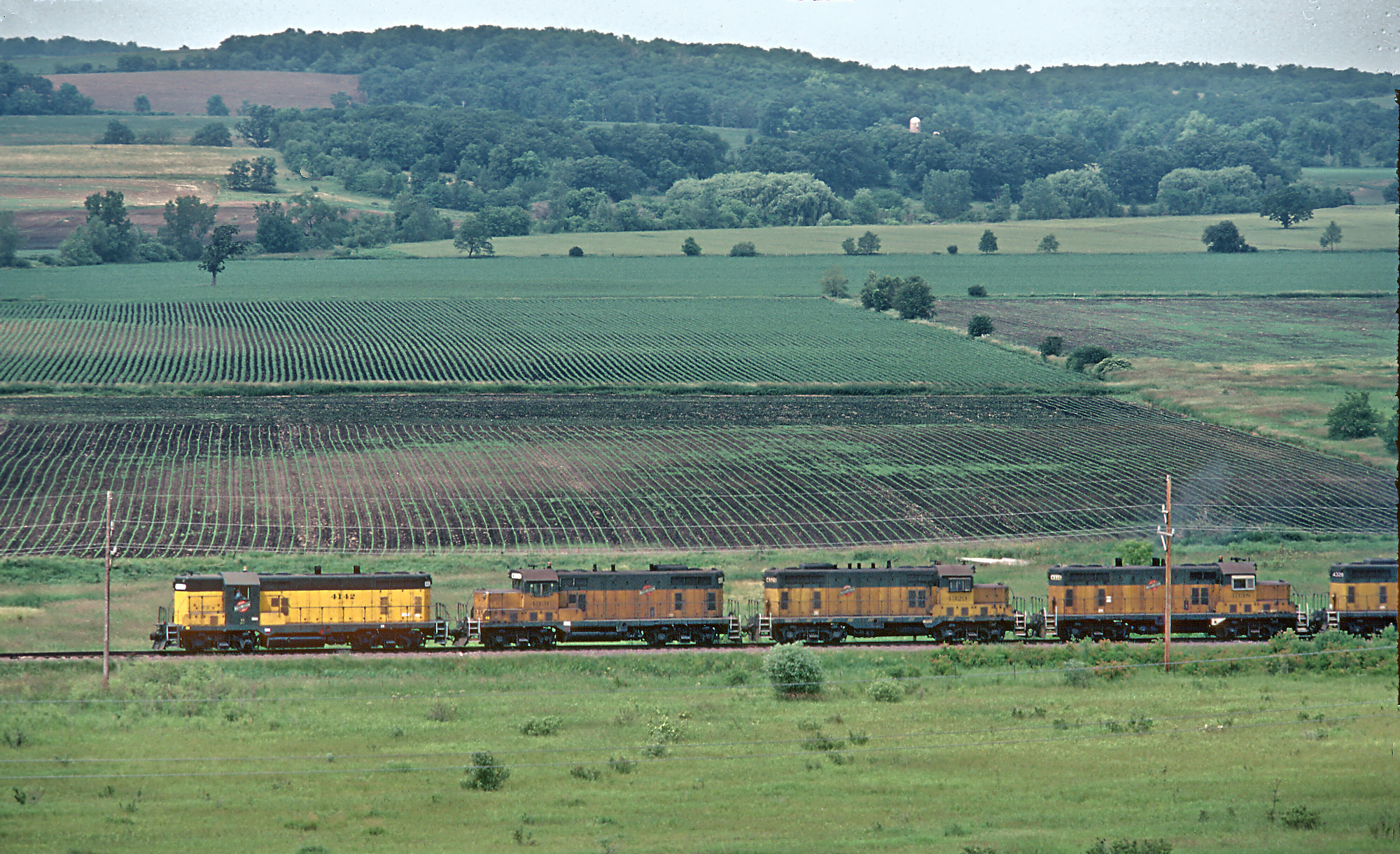Granger Railroads: Classic Midwestern Lines
Published: July 3, 2024
By: Adam Burns
For train enthusiasts the term "granger railroad" was predominately used to describe classic Midwestern systems which derived a significant portion of their annual revenue from the movement of agricultural products.
However, the term also has significant economic connotations regarding freight rates. In this context the term "Granger Railroad" underscores a pivotal era in American history when agricultural communities, particularly in the Midwest, battled against powerful railroad monopolies.
This confrontation spurred significant political and economic reforms in the late 19th and early 20th centuries.
The "Granger Movement" was a grassroots initiative led by farmers to address grievances regarding railroad charges and practices. This article delves into the historical context, specific railroads affiliated with the Granger Movement, and its enduring legacy.
 Rock Island FA-1 #158 and another unit lead Extra 158 on the Illinois Division, circa 1953. American-Rails.com collection.
Rock Island FA-1 #158 and another unit lead Extra 158 on the Illinois Division, circa 1953. American-Rails.com collection.Historical Context
The Granger Movement, spearheaded by the National Grange of the Order of Patrons of Husbandry established in 1867, was a reaction to the monopolistic practices of railroad and grain elevator companies.
Farmers, whose livelihoods depended heavily on fair transport rates and access to markets, found themselves burdened by exorbitant fees and corrupt practices. The movement aimed to advocate for the economic interests of agrarian communities, striving for regulatory measures to curtail the overpowering influence of railroad corporations.
Defining the Granger Railroad
Granger railroads were essentially those railroad lines serving the agriculturally rich Midwestern United States, affecting the livelihoods of thousands of farmers.
Though not formally recognized by a specific grouping, several major and minor railroads were pivotal to the concerns addressed by the Granger Movement.
Key characteristics of these railroads included their extensive reach into the rural Midwest and their significant role in agricultural goods transportation.
Chicago, Burlington & Quincy Railroad
Also known as the Burlington Route, the CB&Q was integral to Midwestern agriculture, running from Chicago and extending throughout Illinois, Iowa, Nebraska, and beyond. Farmers heavily relied on this railroad for shipping their products to major markets. The Burlington's monopolistic tendencies and rate manipulation were recurrent issues of contention for Granger activists.
Chicago and North Western Railway
Operating across Illinois, Iowa, Minnesota, Wisconsin, and into the Dakotas, the C&NW was another major player in Midwestern transport. The railway's extensive network made it a critical lifeline for agricultural zones, hence an important focus for regulatory actions initiated by the Granger Movement. The C&NW was often at the center of disputes over fair freight rates and monopolistic practices.
Chicago, Milwaukee, St. Paul, and Pacific Railroad (Milwaukee Road)
Covering an expansive geography from Illinois and Wisconsin through to Minnesota, Iowa, and the Dakotas, the Milwaukee Road was indispensable for farmers. The railroad's freight policies and pricing were closely monitored and frequently contested by Granger advocates pushing for transparency and fairness.
Atchison, Topeka, and Santa Fe Railway
While primarily known for its extensive network in the southwestern United States, the ATSF's operations in the Midwest substantially impacted farmers in Kansas and surrounding regions. The Granger Movement in these areas often intertwined with broader efforts to diminish the ATSF’s monopolistic control.
Union Pacific Railroad
Union Pacific, with its vast network extending into the agricultural heartlands of Nebraska, Kansas, and Iowa, was also subjected to scrutiny by the Granger Movement. UP’s rates and business practices were frequently seen as emblematic of the broader issues faced by farmers.
Other notable systems included the Chicago Great Western, Rock Island, Minneapolis & St. Louis, and to some extent the Soo Line.
 With the operator providing a roll-by inspection, Chicago Great Western F3A #111-C leads a long freight train westbound past the quaint little depot at Elmhurst, Illinois station on August 14, 1962. Roger Puta photo.
With the operator providing a roll-by inspection, Chicago Great Western F3A #111-C leads a long freight train westbound past the quaint little depot at Elmhurst, Illinois station on August 14, 1962. Roger Puta photo.Legislative and Judicial Milestones
One of the most significant outcomes fueled by the Granger Movement was the advent of regulatory measures aimed at curbing railroad monopolies. A series of legislative and judicial milestones marked the evolution of these efforts.
Granger Laws
Several Midwestern states, inspired by the movement’s advocacy, enacted Granger Laws during the 1870s. These laws aimed at regulating railroad rates and practices to ensure fair treatment for farmers. States like Illinois, Iowa, Minnesota, and Wisconsin led the charge, establishing maximum freight and passenger rates and forming commissions to oversee railroad practices.
Munn v. Illinois (1877)
This landmark Supreme Court case upheld the legality of state regulation of private industries that affect the public interest. The court ruled in favor of the state of Illinois, which had imposed regulations on grain storage facilities and railroad rates, asserting the principle that the state had the authority to regulate private business operations in the public interest.
The Interstate Commerce Act (1887)
The frustrations expressed by the Granger Movement culminated in federal action with the passage of the Interstate Commerce Act. This act established the Interstate Commerce Commission (ICC) to oversee railroad practices and ensure reasonable and just fair rates. It marked the first significant federal effort to regulate private industries in the United States.
The Sherman Antitrust Act (1890)
While not directly a result of the Granger Movement, the Act embodied the broader spirit of curtailing monopolistic power. It was a milestone in the fight against industrial monopolies that extended to railroads and other sectors.
Decline and Legacy
As the 19th century waned, the Granger Movement’s influence began to decline. Several factors contributed to this, including the rise of other farmers’ alliances and the evolution of national political and economic landscapes. However, its legacy endures in several critical ways.
In addition, for these railroads serving America's Heartland the name "granger" largely remained engrained throughout their corporate existence.
Foundation for Future Reform Movements
The Granger Movement laid the groundwork for subsequent agrarian and populist movements, including the Farmers' Alliance and the Populist Party. These movements continued the fight for economic justice and fair practices, broadening their scope to include other industrial and financial monopolies.
Precedents for Government Regulation
The successful advocacy for regulations through state Granger Laws and the establishment of federal oversight via the ICC created critical precedents for government intervention in the private sector. These precedents have continued to influence regulatory policies across various industries.
Empowerment of Rural Communities
Perhaps most significantly, the Granger Movement empowered rural communities, fostering a sense of shared identity and collective action among farmers. This legacy of grassroots organization and advocacy continues to resonate within modern agricultural and rural communities.
Long-Term Economic Policies
The movement also indirectly contributed to the development of long-term economic policies aimed at balancing the interests of different economic groups. Its emphasis on the fairness and transparency of business practices has had continuing relevance in discussions about corporate regulation and public welfare.
 A classic scene of the Chicago & North Western serving the Heartland... Here, rebuilt GP7's and a former Rock Island GP7R (#4142, in the lead) are west of Waukesha, Wisconsin with their freight train in July, 1982. Roger Puta photo.
A classic scene of the Chicago & North Western serving the Heartland... Here, rebuilt GP7's and a former Rock Island GP7R (#4142, in the lead) are west of Waukesha, Wisconsin with their freight train in July, 1982. Roger Puta photo.Conclusion
The granger railroad era symbolizes a profound chapter in American history where rural agrarian societies confronted the overbearing might of railroad monopolies.
The movement encompassing railroads like the Chicago, Burlington & Quincy, the Chicago and North Western, the Milwaukee Road, the Atchison, Topeka and Santa Fe, and the Union Pacific, exemplified the struggle for equitable economic practices. While rooted in the specific challenges of the 19th century, the themes of the Granger Movement—economic justice, grassroots advocacy, and regulatory oversight—continue to resonate today.
The legacy of the granger and the movement they inspired is a testament to the enduring power of collective action in shaping fair and just economic landscapes.
Recent Articles
-
Minnesota - Murder Mystery - Dinner Train Rides
Dec 27, 25 03:50 PM
Murder mystery dinner trains offer an enticing blend of suspense, culinary delight, and perpetual motion, where passengers become both detectives and dining companions on an unforgettable journey. -
Georgia - Murder Mystery - Dinner Train Rides
Dec 27, 25 03:35 PM
In the heart of the Peach State, a unique form of entertainment combines the thrill of a murder mystery with the charm of a historic train ride. -
New Jersey - Wine Tasting - Train Rides
Dec 27, 25 09:57 AM
If you're seeking a unique outing or a memorable way to celebrate a special occasion, wine tasting train rides in New Jersey offer an experience unlike any other.



